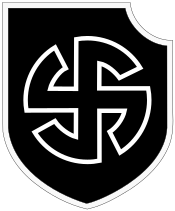5th SS Panzer Division
| 5th SS Panzer Division | |
|---|---|

Unit insignia
|
|
| Active | 1941–45 |
| Country |
|
| Branch |
|
| Type | Panzer |
| Role | Armoured warfare |
| Size | Division |
| Engagements | Eastern Front |
| Commanders | |
| Notable commanders |
Felix Steiner Herbert Gille Eduard Deisenhofer Johannes Mühlenkamp Karl Ullrich |
The (German: ) was a Panzer division among the thirty eight Waffen-SS divisions of Nazi Germany. It was recruited from foreign volunteers in Denmark, Norway, Sweden, Finland, Estonia, the Netherlands and Belgium under the command of German officers. During the course of World War II, the division served on the Eastern Front. It surrendered in May 1945 to the American forces in Austria.
After the invasion of Poland in 1939, Reichsführer-SS Heinrich Himmler sought to expand the Waffen-SS with foreign military volunteers for the "crusade against Bolshevism". The enrolment began in April 1940 with the creation of two regiments: the Waffen-SS Regiment Nordland (for Danish, Norwegian, and Swedish volunteers), and the Waffen-SS Regiment Westland (for Dutch, and Flemish volunteers).
After formation the division was sent to Heuberg in Germany for training and by April 1941, SS Division was ready for combat. It was ordered east in mid-May, to take part with Army Group South's advance into the Ukraine during Operation Barbarossa, the invasion of the Soviet Union. In June 1941 the Finnish Volunteer Battalion of the Waffen-SS was formed from volunteers from that country. After training, this unit was attached to the SS Regiment Nordland of the division. About 430 Finns who fought in the Winter War served within the SS Division division since the beginning of Operation Barbarossa. In spring 1943 the Finns 2-year contract ended, and the Finnish battalion was withdrawn. During that same timeframe, the was removed to help form the core of the new 11th SS Volunteer Panzergrenadier Division Nordland. They were replaced by the Estonian infantry battalion Narwa.
The division took part in Operation Barbarossa, the invasion of the Soviet Union, advancing through Galicia, Ukraine. In August the division fought for the bridgehead across the Dniepr River. Later, the division took part in the heavy fighting for Rostov-on-Don before retreating to the Mius River line in November. In the summer of 1942, took part Army Group South's offensive Case Blue, aimed at capturing Stalingrad and the Baku oilfields. In late September 1942, participated in the operation aimed to capture the city of Grozny, alongside the 13th Panzer Division. The division captured Malgobek on 6 October, but the objective of seizing Grozny and opening a road to the Caspian Sea was not achieved. The division took part in the attempt to seize Ordzhonikidze. The Soviet Operation Uranus, the encirclement of the 6th Army at Stalingrad, brought any further advances in the Caucasus to a halt.
...
Wikipedia
